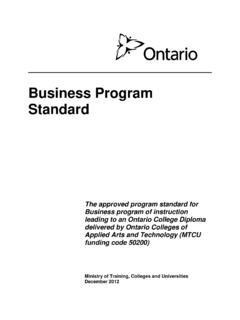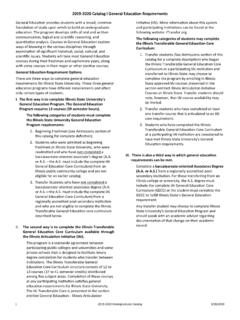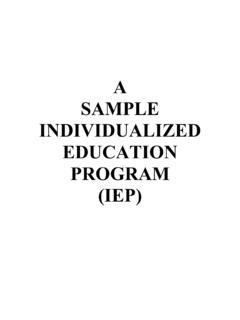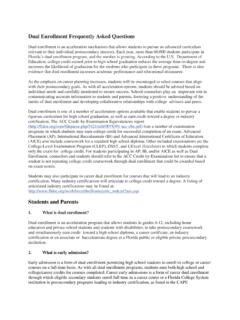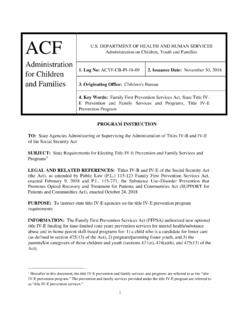Transcription of Texas Education Agency Dual Credit Frequently Asked …
1 Texas Education Agency dual Credit Frequently Asked Questions General Information About dual Credit 1. What is dual Credit ? dual Credit is a process through which a student may earn high school Credit for successfully completing a college course that provides advanced academic instruction beyond, or in greater depth than, the Texas Essential Knowledge and Skills (TEKS) for a corresponding high school course. The dual Credit . earned is college Credit and high school Credit for one course. 2. Are school districts required to offer dual Credit to students? No. Texas Education Code requires the following: Each school district shall implement a program under which students may earn the equivalent of at least 12 semester Credit hours of college Credit in high school.
2 Each school district shall annually report to the Agency (1) the number of district students, including career and technical students, who have participated in the program and earned college Credit ; and (2) the cumulative number of courses in which participating district students have enrolled and college Credit hours the students have earned. The opportunity for at least twelve college Credit hours can be met through dual Credit , but it can also be met through Advanced Placement , International Baccalaureate, and advanced technical Credit courses, including locally articulated courses. 3. Where are the administrative rules regarding dual Credit ? State Board of Education - Texas Administrative Code Texas Higher Education Coordinating Board - Texas Administrative Code It is important to access both sets of rules in order to understand dual Credit requirements.
3 4. How do colleges and high schools work together to build dual Credit programs? Collaboration between the high school and the college is a crucial element of a dual Credit program. The written agreement (often referred to as an articulation agreement, an institutional agreement, or a partnership agreement) drawn up between the public school district and the institution of higher Education should define the nature of this collaboration. (Please see question #5 for more information on requirements of written agreements.). Last updated August 12, 2011. Among other things, colleges can assist with scholarships, transfer agreements for designated courses, designing curricula, training and supporting instructors, and administering college placement tests that ensure adequate rigor and student knowledge.
4 Similarly, high schools can allow their instructors to teach for a local college in order to offer courses for dual credits, provide high school graduation requirement counseling, and supplement instruction to ensure mastery of the Texas Essential Knowledge and Skills (TEKS). 5. What kind of agreement is required in dual Credit partnerships? The Texas Administrative Code, and , requires that any dual Credit partnership between a secondary school and a public college include a written agreement (often referred to as an articulation agreement, an institutional agreement, or a partnership agreement) approved by the governing boards or designated authorities of both institutions. The agreement must address at least the following elements: Eligible Courses Student Eligibility Location of Class Student Composition of Class Faculty Selection, Supervision, and Evaluation Course Curriculum, Instruction, and Grading Academic Policies and Student Support Services Transcripting of Credit Funding 6.
5 What is the difference between dual Credit and concurrent enrollment? Concurrent enrollment refers to a circumstance in which a student is enrolled in two or more educational institutions at the same time (for example, a college and a university, or a high school and a college). Concurrent enrollment may also be referred to as dual enrollment. While dual Credit may be viewed as a form of concurrent enrollment because the student is enrolled in both high school and college, the Credit earned is awarded by both institutions. Course Requirements 7. Can high school Credit be awarded for any college course? No. It is the responsibility of the institutions entering into a dual Credit partnership to ensure the following requirements are met: a.
6 Courses offered for dual Credit by public two-year associate degree granting institutions must be identified as college-level academic courses in the current edition of the Texas Higher Education Coordinating Board's Lower Division Academic Course Guide Manual (ACGM) or as Last updated August 12, 2011. college-level technical Education courses in the current edition of the board's Workforce Education Course Manual (WECM). b. Courses offered for dual Credit by public universities must be in the approved undergraduate course inventory of the university. Public colleges may not offer remedial or developmental courses for dual Credit . c. Courses offered for dual Credit must provide advanced academic instruction that allows for mastery of the Texas Essential Knowledge and Skills (TEKS) for the appropriate high school course and that goes beyond or into greater depth than those TEKS.
7 (Please see question #56. for additional detail.). These requirements should be specified in the written agreement drawn up by the partner institutions. 8. Who is responsible for the content of a course offered for dual Credit ? Because the course is a college course, the college is responsible for the content. However, because the high school is also awarding Credit , the public school district is responsible for ensuring that the student has an opportunity to master the Texas Essential Knowledge and Skills (TEKS). The district may do so through a review of the course syllabus as it is taught at the partner institution. If it is determined that all the TEKS are not included in the course, the district may work with the institution of higher Education to enhance the course and/or may provide supplemental instruction.
8 9. What is a course equivalency crosswalk (also referred to as an articulation chart)? The course equivalency crosswalk is an officially approved document that matches coursework between schools and/or establishes procedures for reviewing courses that may be offered for dual Credit . The course equivalency crosswalk should be a part of the written agreement. One example can be seen at (Please see question #5 for more information on requirements of written agreements.). 10. Where are courses for dual Credit taught? Courses for dual Credit may be taught on the college campus, on the high school campus, on a satellite campus, or online. 11. Can a one-semester college course be offered over two semesters in order to accommodate the high school schedule?
9 Colleges are responsible for determining the length of their courses and making decisions regarding an extended schedule. Last updated August 12, 2011. Teacher Requirements 12. Who teaches a college course for dual Credit ? dual Credit teachers must be regularly employed faculty members of the college or must meet the same or equivalent standards (including minimal requirements of the Southern Association of Colleges and Schools) and approval procedures used by the college to select faculty responsible for teaching the same courses to non-high school students at the college. 13. What certifications must a teacher have to teach a course for dual Credit ? For college-level academic courses, the Southern Association of Colleges and Schools (SACS) requires a master's degree or doctoral degree with 18 graduate hours in the discipline being taught.
10 For workforce Education courses, SACS requires a bachelor's degree in the discipline or an associate's degree plus demonstrated competencies in the discipline. When districts partner with technical or community colleges to offer dual Credit , including local or statewide articulated Career and Technical Education (CTE) courses, the postsecondary faculty must meet SACS teacher requirements. College faculty are not required to obtain certification through the State Board of Educator Certification when teaching high school students for dual Credit . Courses for dual Credit may be taught by appropriately-qualified public Education employees or by employees of the institution of higher Education . 14. Are college faculty who teach courses for dual Credit subject to fingerprinting requirements under Texas Education Code (TEC) , Criminal History Record Information Review of Certain Contract Employees?

